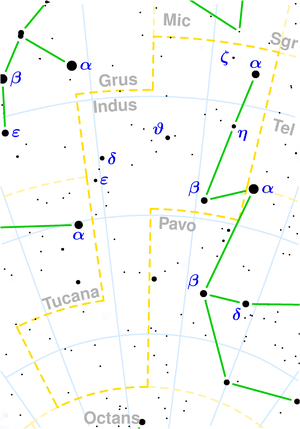 | |
| List of stars in Indus | |
| Abbreviation: | Ind |
| Genitive: | Indi |
| Symbolism: | the Indian |
| Right ascension: | 21 h |
| Declination: | −55° |
| Area: | 294 sq. deg. (49th) |
| Main stars: | 3 |
| Bayer/Flamsteed stars: | 16 |
| Stars with known planets: | 1 |
| Bright stars: | none |
| Nearby stars: | 1 |
| Brightest star: | "The Persian" (α Ind) (3.11m) |
| Nearest star: | Epsilon Ind (11.82 ly) |
| Messier objects: | none |
| Meteor showers: | None[1] |
| Bordering constellations: | Microscopium Sagittarius (corner) Telescopium Pavo Octans Tucana Grus |
| Visible at latitudes between +15° and −90° Best visible at 21:00 (9 p.m.) during the month of September | |
Indus (pronounced /ˈɪndəs/) is constellation in the southern sky. Created in the sixteenth century, it represents an Indian, a word that could refer at the time to any native of Asia or the Americas.
Contents[hide] |
[edit] Notable features
The brightest star in the constellation, Alpha Indi, is visual magnitude 3.11.
Epsilon Indi is one of the closest stars to Earth, approximately 11.82 light years away. The system has been discovered to contain a pair of binary brown dwarfs, and has long been a prime candidate in SETI studies.[2][3]
[edit] History
The constellation was one of twelve created by Petrus Plancius from the observations of Pieter Dirkszoon Keyser and Frederick de Houtman and it first appeared on a 35-cm diameter celestial globe published in 1597 (or 1598) in Amsterdam by Plancius with Jodocus Hondius. The first depiction of this constellation in a celestial atlas was in Johann Bayer's Uranometria of 1603.[4][5] Plancius portrayed the figure as a nude male with arrows in both hands but no bow.[6]
[edit] References
- ^ Anonymous (February 3, 2007). "Meteor Showers". American Meteor Society. http://www.amsmeteors.org/showers.html. Retrieved on 2008-05-07.
- ^ Burnham, Robert; Luft, Herbert A. (1978). Burnham's Celestial Handbook: An Observer's Guide to the Universe Beyond the Solar System. Courier Dover Publications. ISBN 0486235688.
- ^ Lawton, A. T. (1975). "CETI from Copernicus". Spaceflight 17: 328–330. http://adsabs.harvard.edu/abs/1975SpFl...17..328L. Retrieved on 2008-07-02.
- ^ Bakich, Michael E. (1995). The Cambridge Guide to the Constellations. Cambridge University Press. ISBN 0521449219.
- ^ Sawyer Hogg, Helen (1951). "Out of Old Books (Pieter Dircksz Keijser, Delineator of the Southern Constellations)". Journal of the Royal Astronomical Society of Canada 45: 215. http://adsabs.harvard.edu/abs/1951JRASC..45..215S. Retrieved on 2008-05-07.
- ^ Allen, Richard Hinckley (1963). Star Names, Their Lore and Meaning. New York: Dover Publications. ISBN 0-486-21079-0.
- Ian Ridpath and Wil Tirion (2007). Stars and Planets Guide, Collins, London. ISBN 978-0007251209. Princeton University Press, Princeton. ISBN 978-0691135564.
[edit] External links
| Wikimedia Commons has media related to: Indus (constellation) |
| ||
| ||
No comments:
Post a Comment